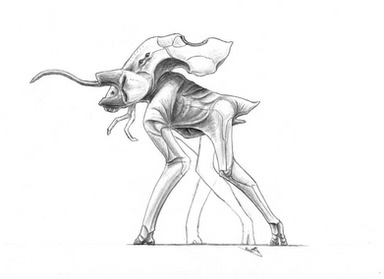HOME | DD
 Sorroxus — (outdated/scrapped) Baropod Xylefsis
Sorroxus — (outdated/scrapped) Baropod Xylefsis

#alien #aliencreature #aliendesign #alienworld #biology #exobiology #speculative #specbio #traditionalart
Published: 2021-04-13 13:53:55 +0000 UTC; Views: 864; Favourites: 14; Downloads: 2
Redirect to original
Description
Baropod Xylefsis
(yes, I know I used this name for one of the stithostomes, but the stithostomes are sort of dead now
Scientific name: baropod xylefsis - (bɛɹʌpʰɑːd/bæɹʌpʰɑːd zaɪlefsɪs)
Common name: brown beetle-cow, beetle-cow
Average weight: 2,500-2,800 lbs (male), 3,000-3,200 lbs (female)
Average height: 1.7-2.0 m (male), 2.0 m (female)
The Baropod Xylefsis (lit. lumbering heavy-foot) is a member of the baropoda genus. The creature inhabits the inner steppe-plains of the west coast of Concordia, the largest continent on the stithopod world, where they are treated to a vast wealth of lampaphytes, which fuel their massive weights.
The B. Xylefsis is a very social creature, living in herd-oriented groups numbering anywhere from 30 to 50 members, with about 5-7% of the herd consisting of “calfs,” and the caves are protected by the rest of the herd, although some calves fall victim to predation. Regardless, the herd is very docile when unprovoked, and many B. Xylefsis form close relationships with certain individuals, though the level of their emotional intelligence is still unknown.
Diet for the B. Xylefsis consists mainly of lampaphytes and short synnefophytes, which are bush-like plants. When grazing and feeding, B. Xylefsis will utilize its hooked pedipalps to rip lampaphytes up from the soil, proceeding to shove the waxy leaves and spongy bulb-shaped main-body into their beak. Their beak does little work, and mostly serves to slice up the bulbous main-body, with the contents of the leaves and sliced bulb being processed in their foregut, which resides in their thorax. Here, rasping and grinding protrusions of teeth-like material will grind up the tough contents before passing it into the main gut in the abdomen.
Common predators of the B. Xylefsis include the S. Dolofonikos, which are more of a pest than they are an actual threat, as well as the Theronychus Tyrannos, which is a ruthless hyper-carnivore and the apex predator of the Concordian west coast. In response to this threat, the B. Xylefsis has evolved a few key defenses, those namely being the sharp and extremely dangerous claws at the ends of their pedipalps, which are a little longer than a man's forearm, as well as their great size which offers some deterrence, and the fatty-pads lining the back of their abdomen, which form a thick protective barrier. However, they are vulnerable from their underside, and the two most common causes of death due to predation include either their head and “neck” being butchered and torn apart or being tipped onto their side or back and then having their abdomen bored into.
B. Xylefsis reach sexual maturity about a year and a half after they’re born, and when they do, males will often release pheromones into the air which alert dominant females that they’re ready for sex, with the dominant females then choosing which male to mate with depending on certain factors. In females, a healthy and dominant sexually mature female presents as a large, muscular creature with vibrant red patterns on their dark orange fat-pads, and in males, sexual maturity and fertility is represented with lighter-orange fat-pads, with patterning being less common. Typically, one female will often choose at least one male, and once the (at least) two have formed a relationship, the female will proceed to mate with the male, and these interactions can often be spontaneous.
Experimented with a new style of shading, and I honestly really like this style so much
























